Ever wondered why cedar is a top choice for outdoor projects? The secrets of this versatile wood might surprise you! Read on to unlock the wonders of cedar.

Cedar is one of the most popular woods in the woodworking world.
It can use pretty much for any woodworking project including decking, siding, trimming, and flooring.
But if you’re looking to use cedar for outdoor furniture to live under harsh conditions, like when making patio furniture, you may have probably been curious about its ability to resist in an outdoor environment.
So, I decided to check it out, and here’s what I’ve found with the help of woodworking experts, Is Cedar good for outdoor use?
Yes, cedar is excellent for outdoor use. It’s naturally resistant to rot, decay, and insects, and can withstand weather changes. Its durability and aesthetic appeal make it a popular choice for decks, furniture, and fences. Regular maintenance enhances its lifespan and preserves its color.
But that isn’t exactly a yes or no question.

So, in this article, I’ll explore is cedar good for outdoor use, the advantages and disadvantages of using cedar for outdoor use, and how to finish cedar for exterior use as well.
Furthermore, I’ll answer some frequently asked questions as well.
Let’s jump in!

Can You Use Cedar for the Exterior?
Yes, you can use cedar for exterior furniture, fences, flooring, benches, and wood carving without any issues.
It has natural resistance against environmental elements such as moisture. Therefore, cedar wood is rot-resistant, decay-resistant, and able to place in humid environments.
Cedar has natural resistance against bugs and insects.
The wood itself releases a chemical called Thujone which acts as a neurotoxic chemical to insects and bugs. It causes nerve damage to bugs and insects.
Thujone is known as a strong antimicrobial chemical that contains in white cedar.
Not only that but Cedar also releases a strong aromatic smell that repels bugs and insects. Because of those reasons, bugs hate cedar wood and furniture made from cedar.
Cedar is a tight-grained, weather-resistant, and beautiful wood with excellent working and finishing properties. It is easy to cut, saw, nail, and drill, and cedar takes stain so well.
Because of the excellent properties of cedar, it can use for outdoor projects without any hesitations.
Cedar is not needed to be treated, stained, or painted, but lasts for years without any damage.
But I highly recommend you treat and finish cedar woodwork, especially before placing them outside because if you leave it untreated, it can weather to a grey, ash color over time.
Plus, even though cedar is so good to use outdoors, it is not hard as strong as hardwoods.
Cedar is a softwood. Therefore, cedar doesn’t live long as hardwoods. To increase its durability, proper maintenance is a must.
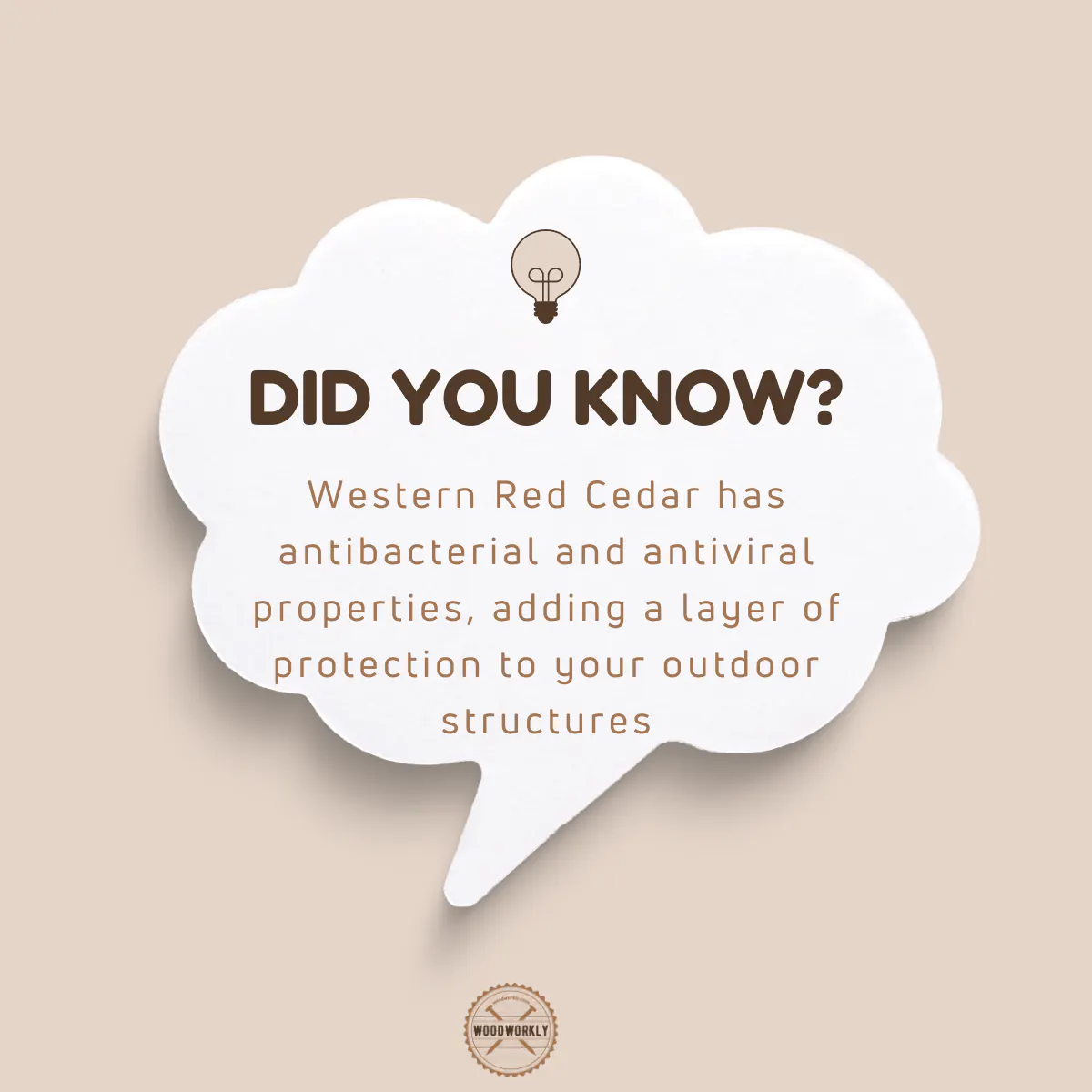
Why is Cedar Good for Outdoors?
Cedar, known for its incredible durability and stunning natural beauty, has long been a popular choice for outdoor applications, from furniture to fencing.
Whether you choose Western Red Cedar or Incense Cedar, you’re investing in a wood that has unique properties making it suited for the outdoors.
Let’s delve into the reasons why cedar stands out for outdoor use.
Natural Beauty
One of the first things you’ll notice about cedar is its captivating aesthetic appeal.
The wood itself is known for its richly textured grain and warm, vibrant hues that range from a reddish-brown in Western Red Cedar to a creamy white in other varieties.
This natural beauty makes cedar a great option for outdoor furniture, decking, and even architectural details.
Over time, cedar naturally ages to a distinctive silver-grey patina, adding character to your outdoor spaces.
Inherent Durability
Cedar offers exceptional durability, often outlasting other wood types when used outdoors.
According to the research articles and several studies, cedarwood can last over 20 years for outdoor structures like pergolas and decks, and between 15 and 20 years for fences or support posts.
That’s a long-term investment in quality!
Resistance to Rot and Insects
One of the cedar’s standout properties is its natural resistance to rot and decay.
This is due to the presence of natural oils and resins in the wood that deters decay-causing organisms.
These oils also repel insects, making cedar less likely to suffer from insect-related damage.
This means your cedar furniture or structures can withstand the elements for many years, even without any treatment.
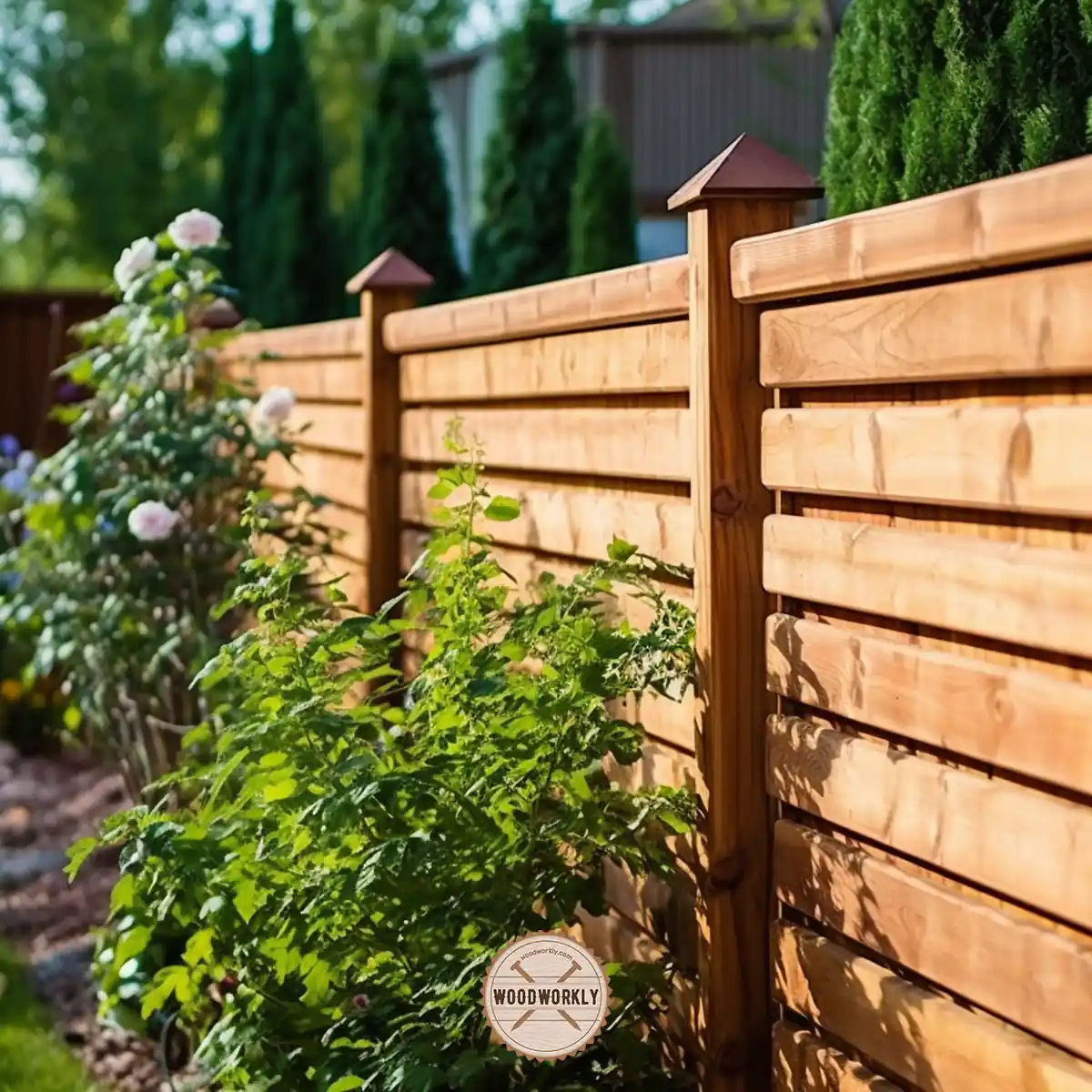
Excellent Moisture Resistance
Cedar’s ability to resist moisture is another big tick in the ‘pro’ column for outdoor use.
It doesn’t warp or sag, even in humid climates, making it a perfect choice for environments that experience significant weather changes.
Plus, tiny air pockets within the grain of the wood offer ingrained insulation, protecting the timber from severe temperature changes and helping prevent warping and expansion.
Easy Maintenance
Maintenance is a significant factor when choosing outdoor materials, and cedar comes up trumps here too.
Its natural durability and resistance to decay mean it requires less upkeep than many other wood types.
Of course, you’ll want to take good care of your cedar structures and furniture, occasional cleaning with a soft cloth and mild detergent will help it retain its natural beauty.
However, despite these advantages, cedar wood isn’t flawless.
It’s not as strong as some hardwoods, can dent relatively easily, and requires regular maintenance to keep its color from fading.
The cost of cedar can also be a consideration as it’s more expensive than some other types of wood like pine.
Despite these minor drawbacks, cedar’s benefits outweigh its disadvantages for most outdoor applications.
Its natural properties coupled with its sheer beauty make it a reliable and attractive choice for your outdoor projects.
So, is cedar good for outdoors? Yes! Whether you’re crafting a beautiful deck, setting up a pergola, or designing stunning outdoor furniture, cedar is a fantastic option to consider.

So, let’s have a look at some major pros and cons of cedar for outdoor use.
Advantages and Disadvantages of Cedar Wood for Outdoor Use
| Advantages | Disadvantages |
| Withstand against high temperatures | Need regular maintenance |
| High workability | Sensitive wood |
| High durability | Color will fade away over time unless it is treated |
| Repel bugs and insects | Weaker than hardwoods |
| Lightweight | Highly sensitive wood |
| Affordable | Flammable |
| Rot and decay-resistant | Develop fuzzy surface over time unless it is treated |
| Aesthetic beautiful appearance | Darken over time under direct sunlight |
| High resistance against outdoor elements |
As you can see, the advantages of cedar wood are so many because of its excellent properties.
Most of the disadvantages can be skipped with the proper finishing method. With proper finishing, cedar furniture and woodwork will last for decades.
Properties of Cedar for Outdoor Use
The properties of cedar wood have a huge impact when it is used for outdoor projects.
When we look at the internal structure of cedar, it has a pores structure with air-filled inside.
Those air-filled pockets are useful to protect the wood from extremely high and low-temperature levels.
This is why cedar benches are comfy even during the hottest months of summer.
Even though cedar is considered a softwood, it has high compressive and bending strength than some hardwoods as well.
The compressive and bending strengths of cedar are as follows compared to a well-known hardwood Aspen,
| Wood Type | Compressive Strength | Bending Strength |
| Red Cedar (Softwood) | 4,560 psi | 7,500 psi |
| Aspen (Hardwood) | 4,250 psi | 8,400 psi |
As you can see, this is why cedar is so good to use for outdoor use, it has some excellent features.
Generally, cedar wood is cheaper than teak wood but lighter than Oakwood.
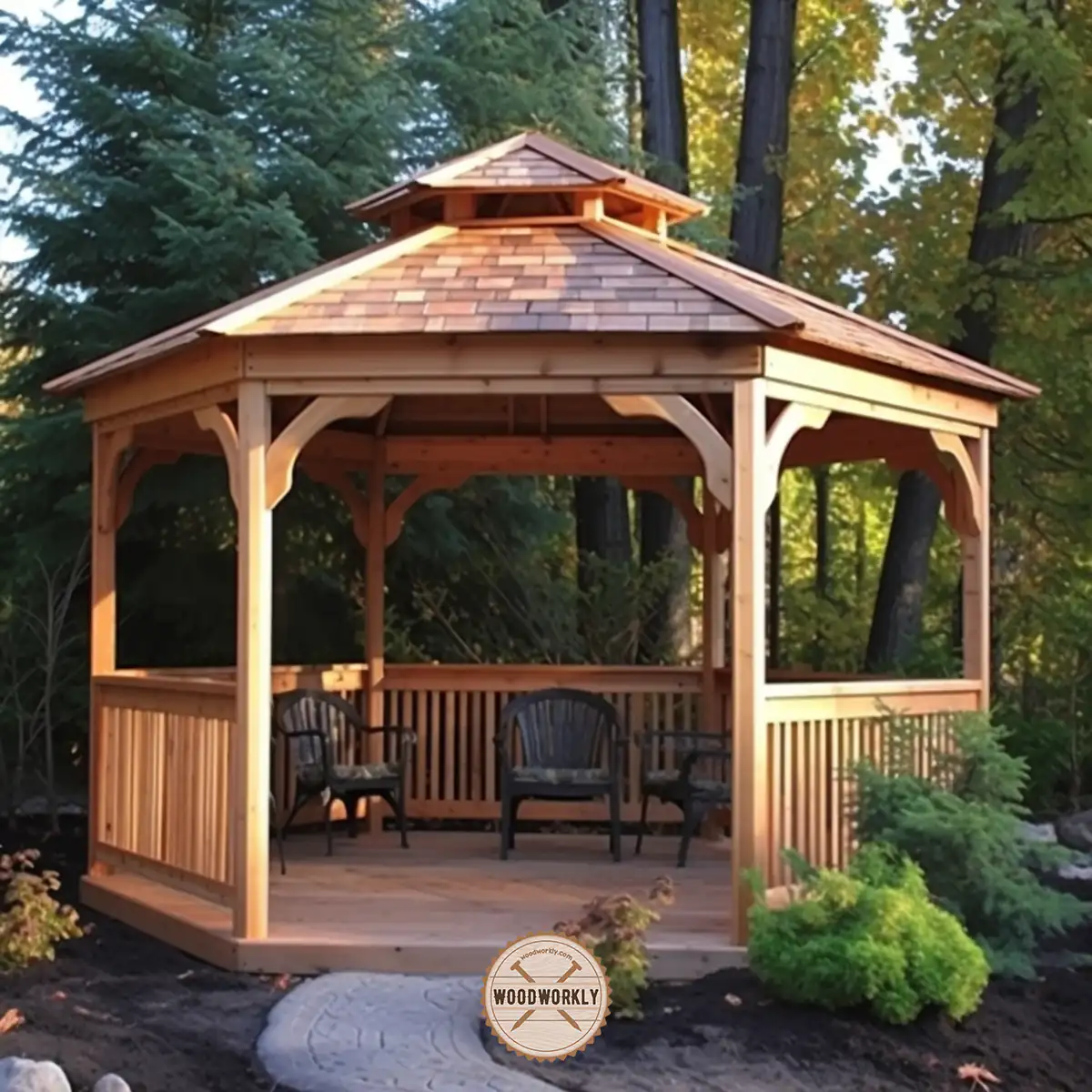
Best Outdoor Finish for Cedar
Choosing the right finish for your cedar can enhance its natural beauty, increase its lifespan, and provide protection from environmental factors.
But when it comes to cedar, not just any finish will do.
So, what is the best finish for outdoor cedar projects? Let’s dive in and find out.
Preserve the Natural Look with Clear Sealant
If you love the look of cedar’s natural grain and don’t mind the eventual silver-gray patina, a clear sealant is a fantastic choice.
Clear finishes allow the cedar’s innate beauty to shine through, showcasing its rich color and unique grain.
However, while clear sealants can protect against moisture and UV rays, they won’t prevent cedar’s natural color from gradually fading over time.
Regular maintenance, usually every one to two years, is crucial to maintain the efficacy of the clear sealant.
Use Semi-Transparent Stain for a Hint of Color
Semi-transparent stain is the best finish when you’re looking to preserve some of the cedar’s natural appearance but want a splash of color.
This type of finish allows the cedar’s grain to show through while also adding a subtle tint.
Like clear sealants, semi-transparent stains provide some protection against moisture and UV damage but will also need to be reapplied regularly for optimal protection.
Choose a Solid Stain for Maximum Color and Protection
If you’re after maximum color and durability, a solid stain is the right choice for your cedar project.
Solid stains offer the most comprehensive protection against UV damage and water absorption, and they’re available in a wide range of colors.
However, keep in mind that a solid stain will obscure much of the cedar’s natural grain.
Oil-Based Finishes for Deep Penetration
Oil-based finishes, like linseed or tung oil, are another excellent choice for cedar.
They penetrate deep into the wood fibers, providing strong protection against moisture.
Furthermore, they enhance the cedar’s grain, lending it a rich, warm glow. However, they will require regular maintenance and reapplication to maintain their protective properties and aesthetic appeal.
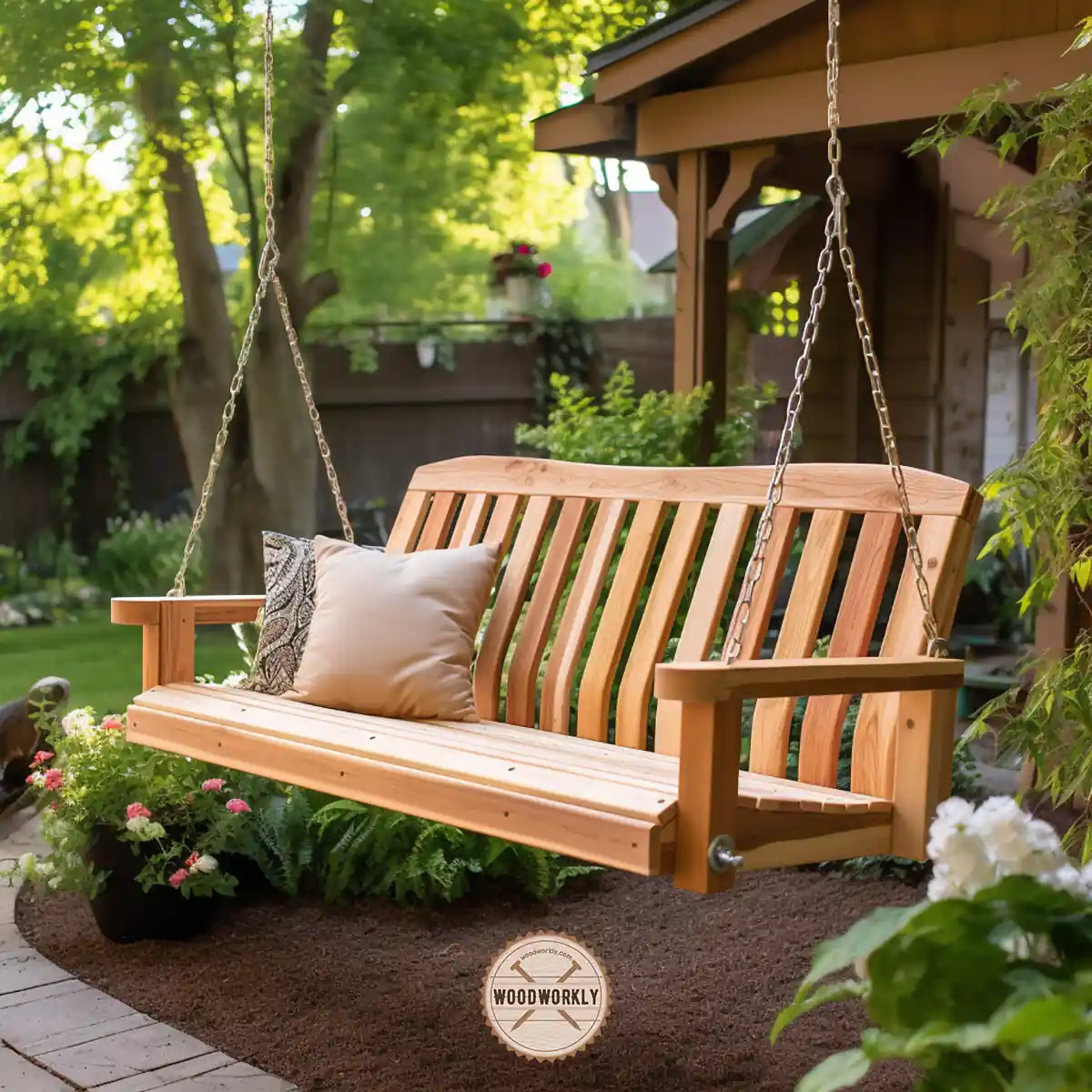
So, let’s discuss how to finish cedar wood for exterior use to eliminate or minimize attacks from environmental elements and increase its durability.
First, look at the supplies you’ll need for the finishing project.
Suppliers You Will Need to Finish Cedar for Outdoors
- Wood stain
- Pre-stain wood conditioner
- Paintbrush for stains
- Clean rags or old clothes
- 220 grit sandpaper
Gather the above tools and materials from a quality manufacturer and head into the cedar wood finishing process.
How To Finish Cedar for Outdoor Use?
Cedar takes stain, paint, and sealer so well.
By finishing cedar wood properly, the wood will get extra protection against environmental elements such as moisture, UV rays, weather changes, and many more.
Plus, it’ll get a nice aesthetic look that adds a unique appearance to your outdoor environment.
By applying stain, you’ll get the natural look of cedar and stain will help the cedar wood to minimize moisture absorption from outside and stop the decaying process.
If you have applied the stain correctly, you’ll be able to get a nice and smooth finish while keeping your loving cedar wood furniture or woodwork for exterior use without any issue.
So, let’s find out how to finish cedar wood using stain for outdoor use.
Here’s the procedure you need to follow when finishing cedar wood for outdoor use,
- Clean and sand the wood surface.
- Apply pre-stain wood conditioner.
- Apply the wood stain.
- Let the wood dry completely.
- Apply additional coats of stains if necessary.
So, let’s explore each of the above steps to finish cedar for exterior use.
This is how you can get a Yes, answer to the burning question, is cedar good for outdoor use?
1. Clean and Sand the Wood
Cleaning is the most essential thing to do before any kind of wood finishing project.
First of all, take a rag or old cloth and wipe down the surface to eliminate dust, debris, and other residues before sanding the wood.
After cleaning the wood, sand the entire surface with 220-grit sandpaper uniformly without missing any spots.
Sand along the direction of the wood grain to avoid wood from scratching and for the better acceptance of wood stain.
Cleaning and sanding help to eliminate unnecessary stuff on wood and make it super smooth to take on stain evenly all over the wood.
220-grit sandpaper is well enough to work with cedar because it is a softwood and higher-grade sandpaper may kill the natural aesthetic appearance of the cedar wood.
Higher grade sandpapers ruin the wood grain and never help the wood to take stains well. Therefore, always select fine-grade sandpaper to work with cedar for better finishing.
After you’re done with sanding, clean the entire surface with a clean rag or old cloth to remove sawdust.
Make sure not to leave dust, debris, and sawdust because that may cause a lot of trouble if they stick with wood stains. Therefore, the cleaning part is a must after sanding.
After you’re done with sanding and cleaning let the wood dry completely for about 24 hours before moving on to the next step.
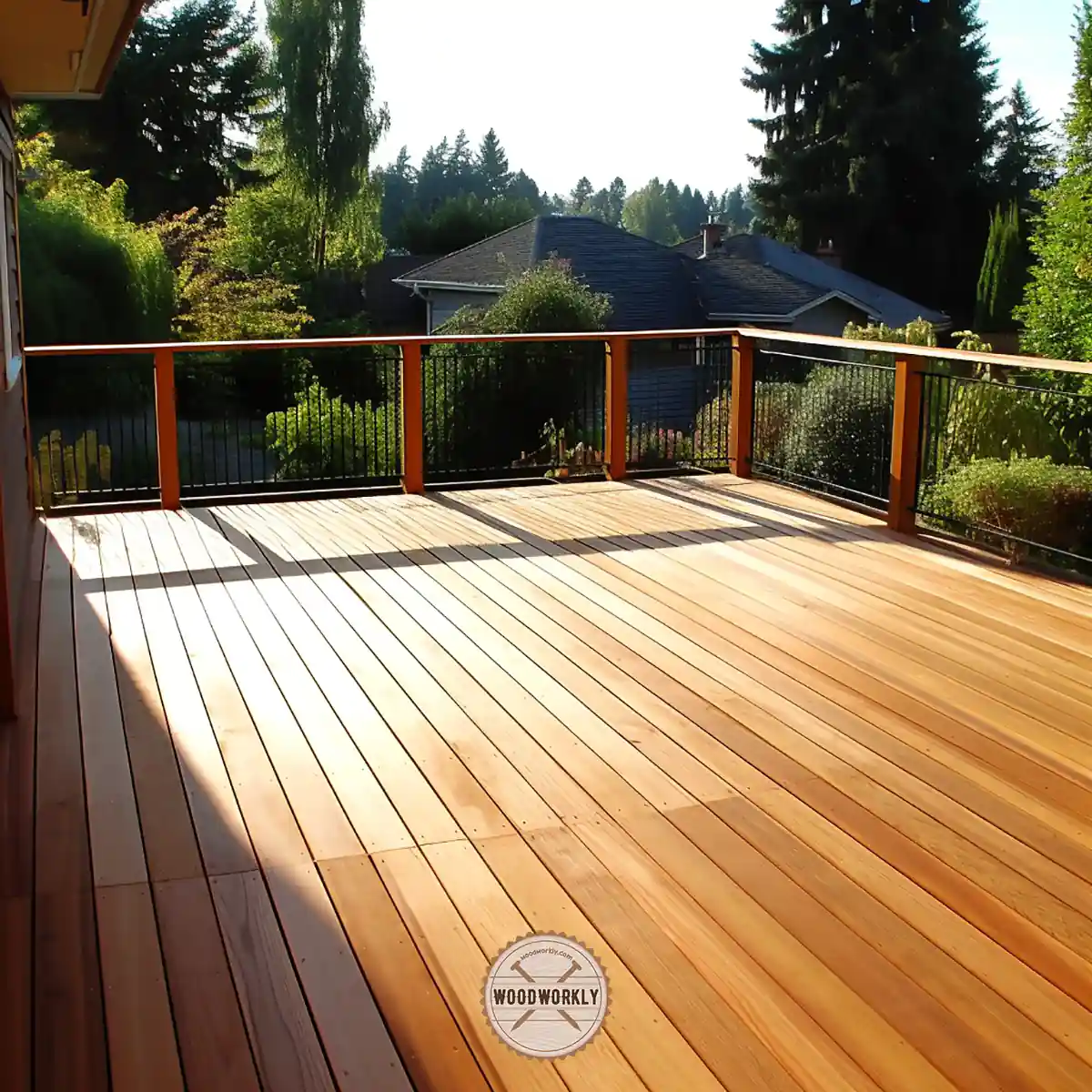
2. Apply Pre-Stain Wood Conditioner
Applying a pre-stain wood conditioner is not an essential step when finishing cedar. But pre-stain wood conditioner helps the wood to take stain evenly throughout the surface preventing surface blotchiness.
Pre-stain wood conditioner helps cedar wood to accept wood stain evenly without making most of the wood stain mistakes such as getting bubbles, streaks, and blotches when applying the stain.
Cedar is a porous softwood. Therefore, it absorbs a lot of stains if the stain is directly applied on cedar wood without applying a pre-stain wood conditioner.
Applying wood conditioner, will limit the absorption of wood stain to the cedar wood and save wasting an unnecessary amount of wood stain by making a thin layer of stain.
A thin layer of stain is efficient in drying and causes fewer troubles.
Even though applying a pre-stain wood conditioner is an optional step, I highly recommend you use a pre-stain wood conditioner before applying wood stain to get promising results.
After applying a pre-stain wood conditioner all over the wood, let the wood sit for about 30 minutes for the absorption process, and wipe off the excess with a damp cloth.
3. Apply The Stain
Now you are good to apply wood stain to cedar wood as a finisher for outdoor use. There’re so many different color options you can go with. Select the one that perfectly goes with your cedar woodwork.
Dip the tip of the paintbrush into the stain and apply a thin layer of stain all over the wood.
Make sure not to dip the paintbrush too much on the stain because the paintbrush itself absorb lots of stains and the tendency of splashing over is less.
Apply wood stain uniformly throughout the cedar wood surface without missing any spots along the direction of the wood grain.
This will prevent stains from crossing with each other because of brush strokes. Apply even pressure on the paintbrush to avoid randomness.
After applying the stain for about 1-2 minutes, immediately wipe off the excess stain with a rag before the excess stain settles on the surface.
Focus more on hard spots because stains tend to sit on top of the hard spots than soft spots.
Wiping off excess stains will prevent from happening lots of wood stain mistakes.
Make sure to apply the stain in a well-ventilated area for good air circulation to avoid contact with harsh chemicals in wood stain.
Tip:
Better to apply a stain or sealer that protects wood from moisture and UV rays. Some ingredients in the wood sealer or wood stain contain UV protectant chemicals that protect outdoor cedar furniture and make them last for years.
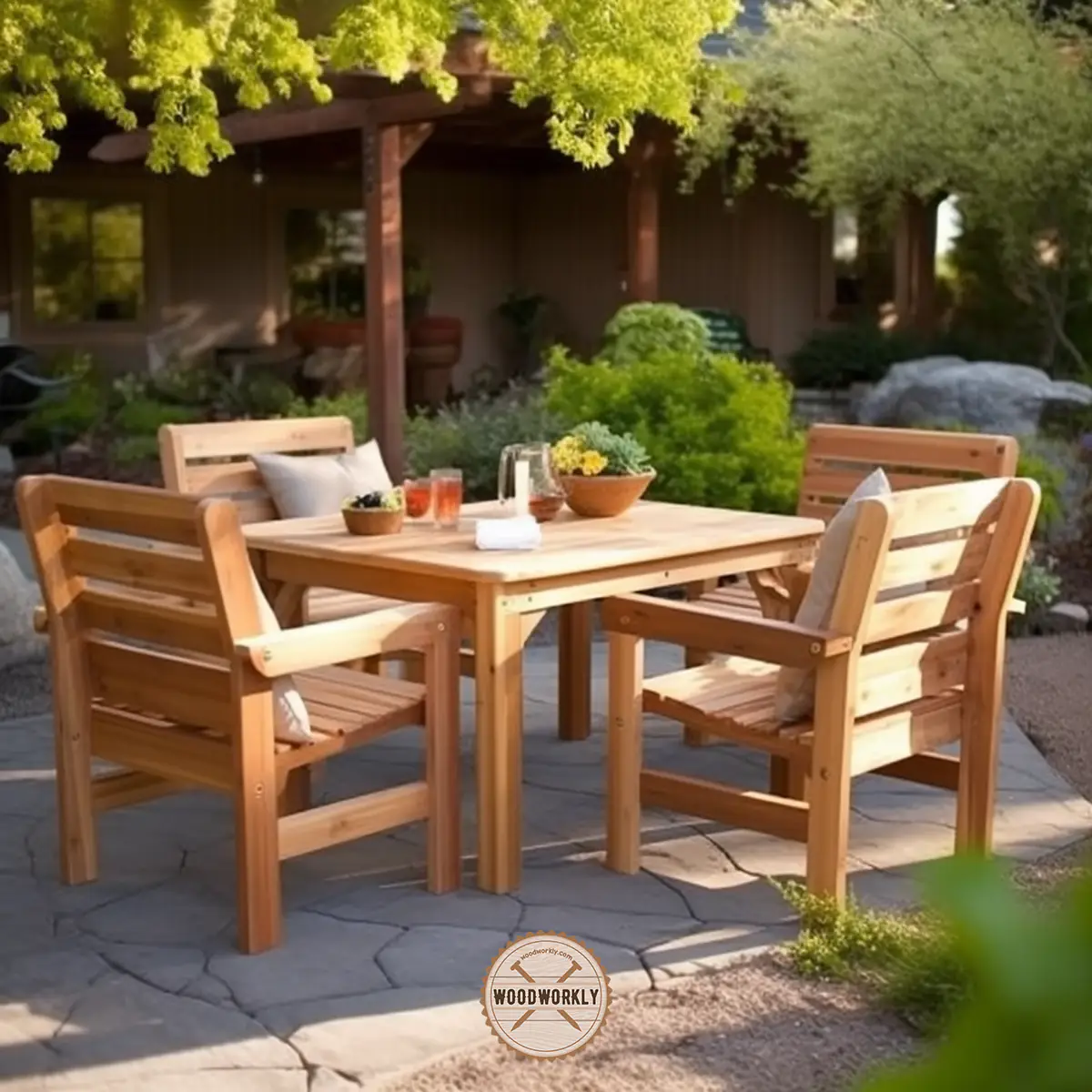
4. Let The Wood Dry Completely
After applying the first coat of stain, let it dry for about 24 hours. But this depends on the weather conditions.
However, don’t go for the second coat of stain until the first coat of stain is fully dry.
Usually, the average drying time of wood stains is 24 hours. Applying the next coat of stain before the first coat is completely dry, may cause surface blotchiness.
Surface blotchiness is a huge mistake in wood finishing and to fix that, you’ll have to scrape the wood stain and start over from the beginning which is so frustrating to do.
So, drying is so much important when finishing cedar for outdoor use.
To protect cedar furniture and woodwork cover them up during the off-season.
Even though cedar has good resistance against environmental elements such as moisture and temperatures, exposure too much to extreme environmental changes like snow and rain could decrease the lifetime of cedar wood.
Therefore, better if you can move outside cedar furniture to a covered area or cover them up during the off-season for better protection.
That’s it, folks! Now you know all about is cedar good for outdoor use carving and woodworking and how to finish cedar for exterior use with a step-by-step guideline process.
The process we have discussed above is the most simple and accurate method of finishing cedar wood for outdoor use.
I highly advise you to stain scrap cedar wood pieces before moving on to the main project to get good results especially if you’re a beginner in woodworking.
After staining cedar wood, better to apply proper oil finishes like Tung oil or Linseed oil on cedar wood to get the maximum protection from the outside world.
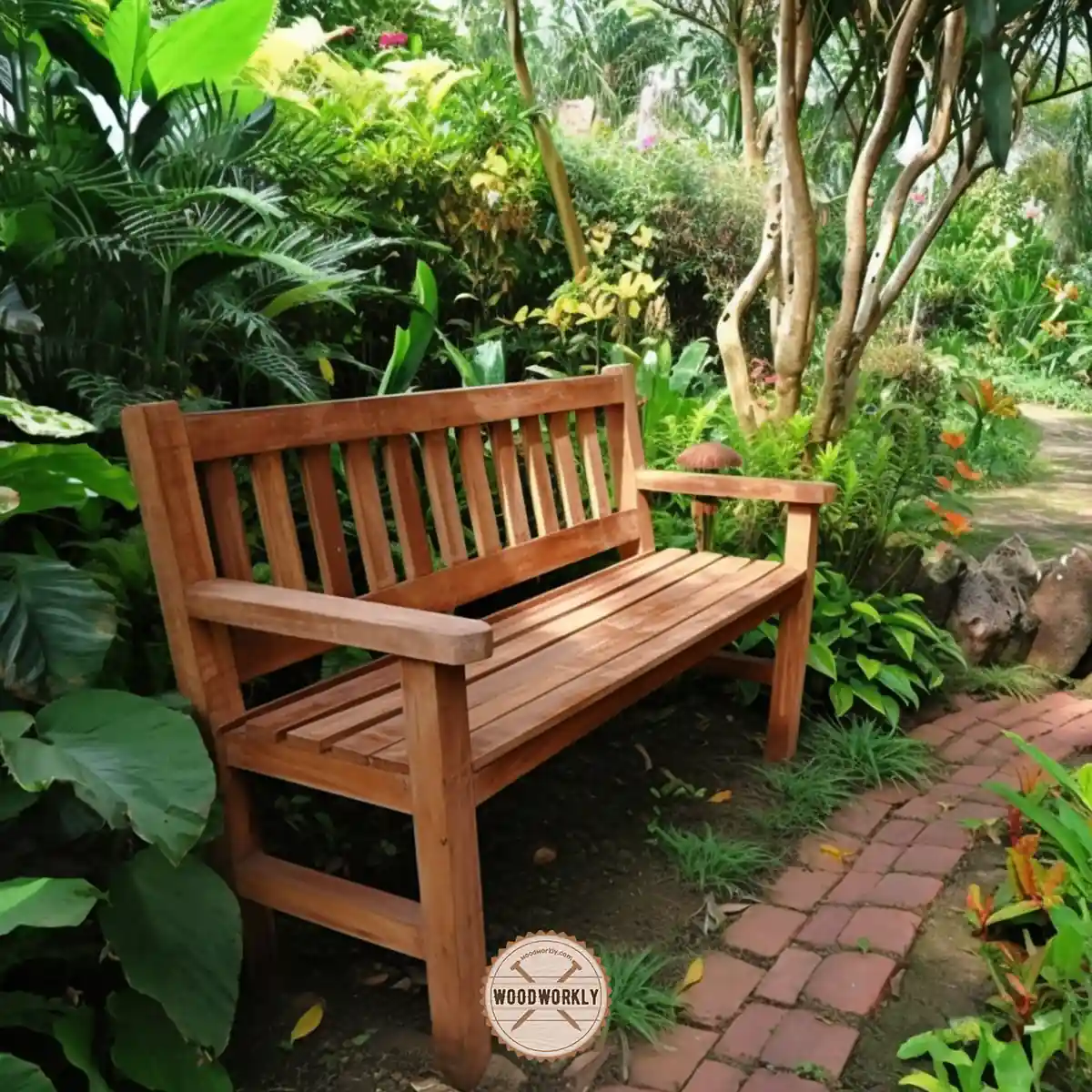
Is Cedar Naturally Rot Resistant?
Yes, Cedar is naturally rot-resistant because it repels bugs and insects, has natural moisture resistance, and decay resistance, and doesn’t need to be treated, painted, or stained.
It already has good resistance against environmental elements.
If you need to know more info, read my comprehensive guide about, How to protect outdoor furniture elements!
Cedar oil and chemicals that release from the wood are called Thujone to protect the wood from insects and bug attacks.
Plus, it has air-filled pore structures that help the wood protect against extreme high and low-temperature levels.
Cedar has a strong odor that is harmful to bugs and insects but pleasing for humans.
This will prevent fungal growth inside cedar wood furniture and woodwork and stop wood from rotting.
Outdoor Application of Cedar
Here’re some common popular outdoor applications of cedar,
- Pergolas
- Benches
- Porch swings
- Outdoor storage houses
- Tables
- Chairs
- Gazebos
- Fences
- Decks
- Shingles
As you can see with regular maintenance and proper finishing you can use cedar wood pretty much for any outdoor application.
How Long Will Cedar Last Outside?
With proper finishing and regular maintenance, cedar will last outside 20 years or longer.
Cedar outdoor uses that contact with the ground such as fences last outside 10 to 20 years or longer. Cedar lasts outside untreated for about 10 years.
Here’s some average lifetime of cedar outdoor furniture and woodwork.
| Cedar Outdoor Use | Average Lifetime |
| Pergolas | 20 years |
| Benches | 15 years |
| Porch swings | 20 years or longer |
| Outdoor storage houses | 10 years or longer |
| Tables | 15 years |
| Chairs | 20 years |
| Gazebos | 10 years |
| Fences | 10 – 20 years |
| Decks | 20 years |
| Shingles | 15 years |
Note:
The above values are only for the cedar furniture that finish and maintain regularly. With proper care, all the cedar wood furniture and woodwork will last for decades.
That’s it, folks! Now you know everything you need to know about, Is cedar good for outdoor use and how to finish it for outdoors.
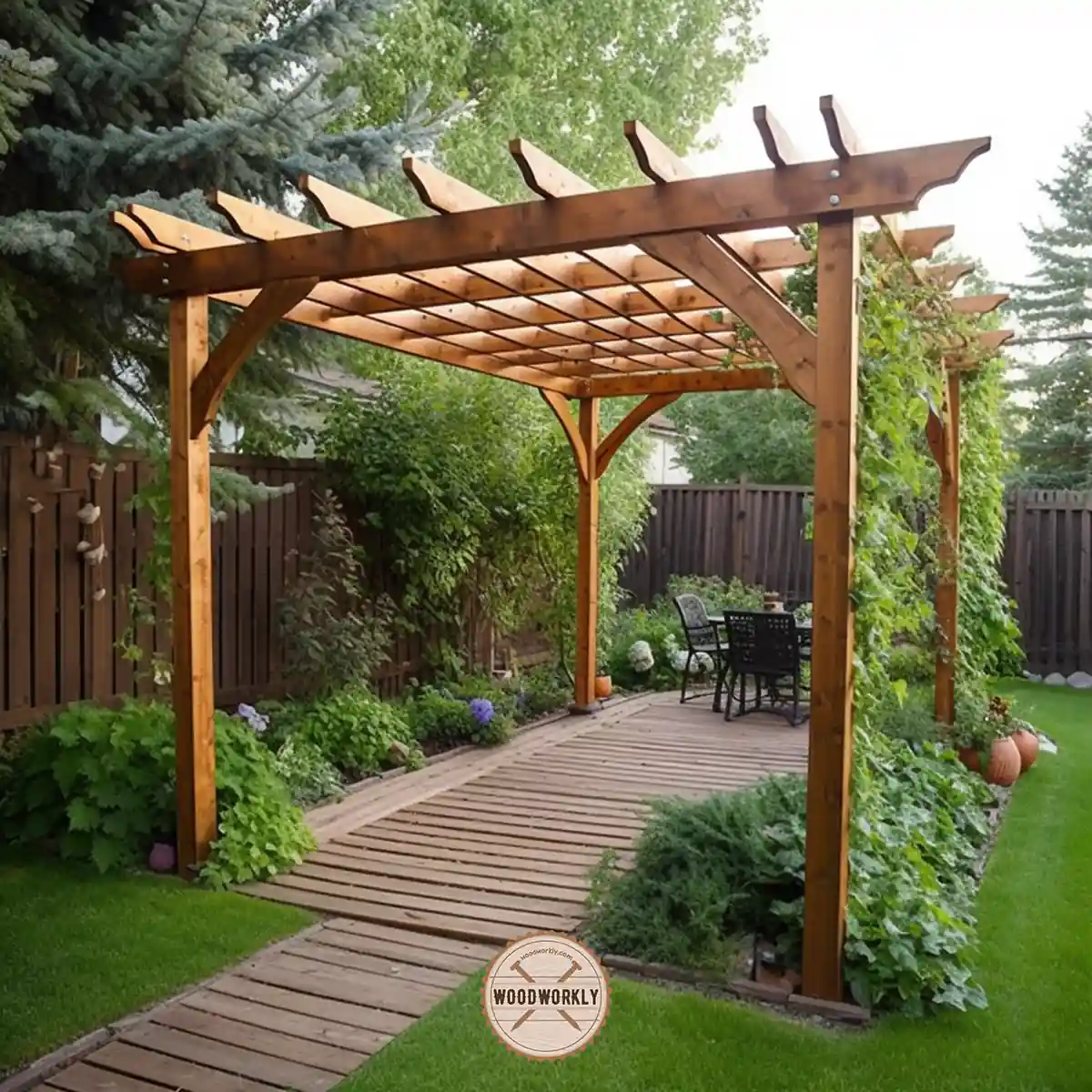
Let’s answer some frequently asked questions as well.
FAQs
What type of finish is best for outdoor cedar furniture?
For outdoor cedar furniture, a high-quality water-repellent preservative or an oil-based penetrating stain is usually the best choice. These finishes maintain cedar’s natural beauty while providing protection from the elements.
Should I stain or seal my outdoor cedar wood?
Both staining and sealing can offer protection, but the choice depends on your preference. Stain can enhance the natural grain and color of cedar, while a clear sealant preserves its natural look.
How often should I refinish my cedar outdoor furniture?
The frequency of refinishing depends on the local climate and the finish used. Typically, cedar outdoor furniture should be refinished every 1-2 years to maintain its appearance and durability.
Do I need to sand cedar before applying a finish?
Yes, sanding cedar before applying a finish ensures a smooth surface for even application and better adhesion of the finish.
Can I use a polyurethane finish on cedar outdoor furniture?
While polyurethane offers excellent protection, its film-like layer can crack and peel in harsh outdoor conditions. It’s better to use a finish designed specifically for outdoor use, such as a penetrating oil stain.
What happens if I don’t finish my cedar outdoor furniture?
If left unfinished, cedar will gradually weather to a silver-gray color, and while it will still resist rot and decay, it may become more susceptible to surface roughening and checking over time.
How do I maintain the finish on my cedar outdoor furniture?
Maintenance involves regular cleaning with mild detergent and occasional reapplication of the finish. Always follow the manufacturer’s instructions when reapplying the finish.
Is painting a good option for finishing cedar outdoor furniture?
While painting can provide a strong protective layer and a wide range of color options, it obscures the natural beauty of cedar. Paint also requires more maintenance as it can peel and chip over time.
Can you leave cedar untreated?
Yes, cedar can be left untreated due to its inherent resistance to rot and insect damage. However, untreated cedar will gradually turn a silver-gray color and may show signs of weathering over time.
What happens if cedar gets wet?
When cedar gets wet, it absorbs water but due to its natural resistance to decay, it doesn’t damage easily. However, constant exposure to moisture can lead to warping or swelling, so it’s important to let it dry properly after rain or cleaning.
Is Cedar weather-resistant?
Yes, cedar is highly weather-resistant. Its natural oils and resins make it resistant to decay and rot, even in harsh weather conditions. However, to maintain its appearance and durability, it should be finished with a quality sealant or stain.
Did I cover all you wanted to know about: Is Cedar Good for Outdoor Use?
In this article, I have deeply discussed is cedar good for outdoor use with the pros and cons of cedar to use for outdoor applications and we have explored, how to finish cedar for exterior use with a highly explained step-by-step process.
Cedar is an excellent wood for outdoor use. Cedar is rot and decay-resistant. It repels bugs and insects. Working with cedar wood is easy. With proper finishing cedar furniture and woodwork are great for outdoor use. Cedar is an ideal wood for humid climates.
Furthermore, I have answered some frequently asked questions as well.
Hope you have gained good knowledge about whether is cedar good for outdoor use like for outdoor furniture and woodwork.
So, let’s make your next woodworking project with cedar and try to finish it as we discussed throughout this article to make it last long over decades.
Have fun in woodworking!